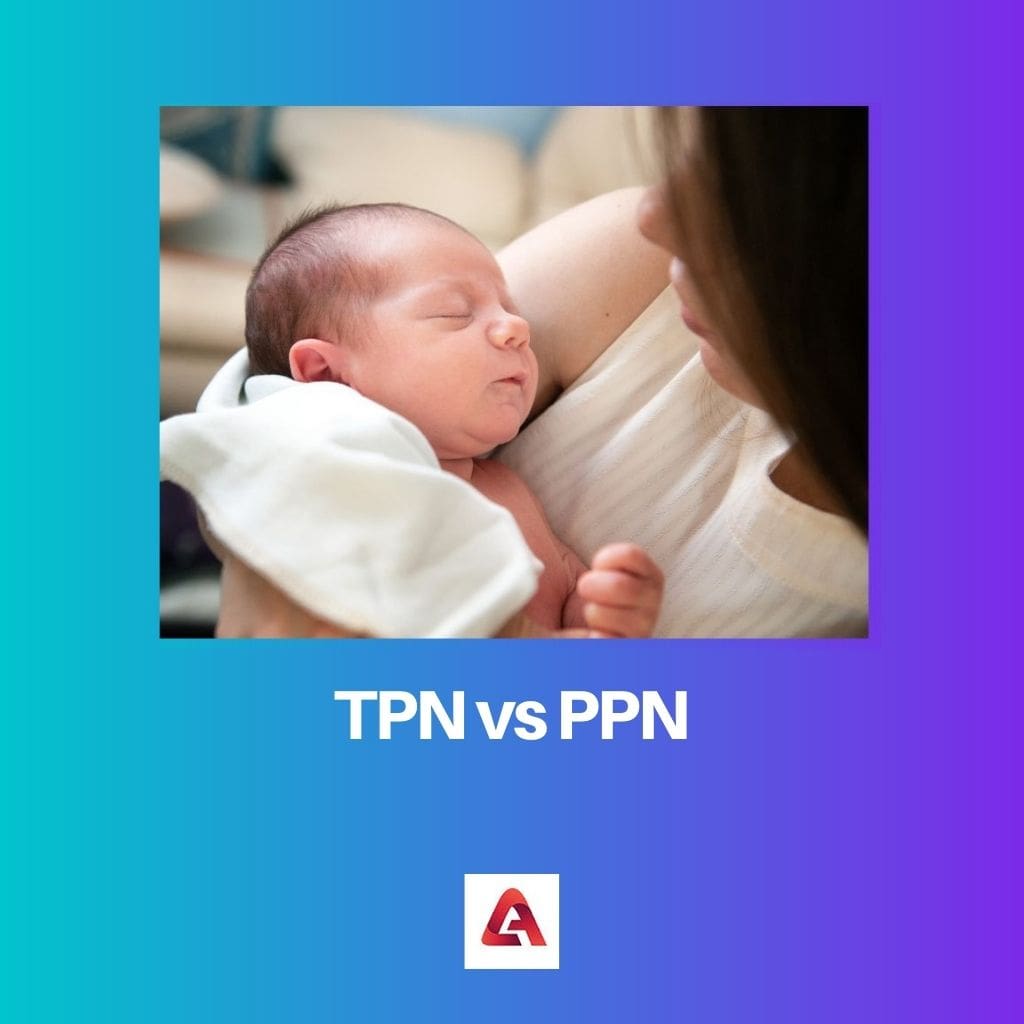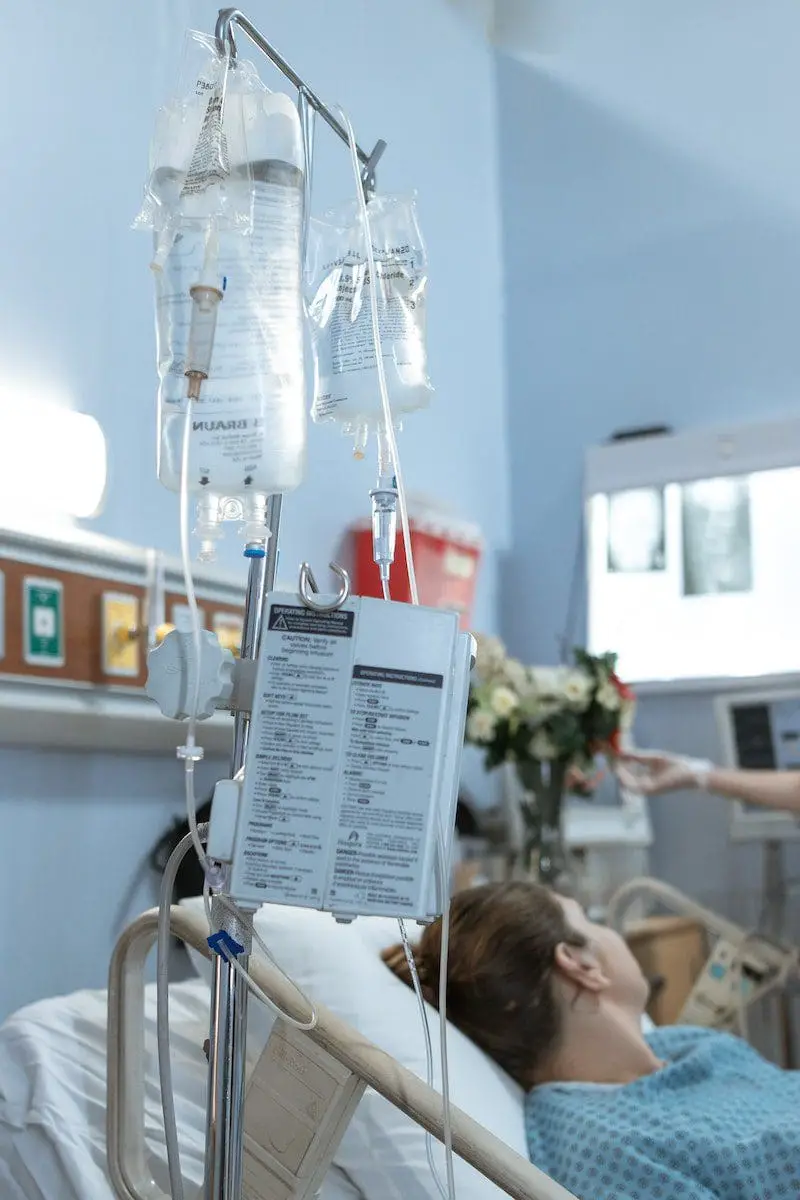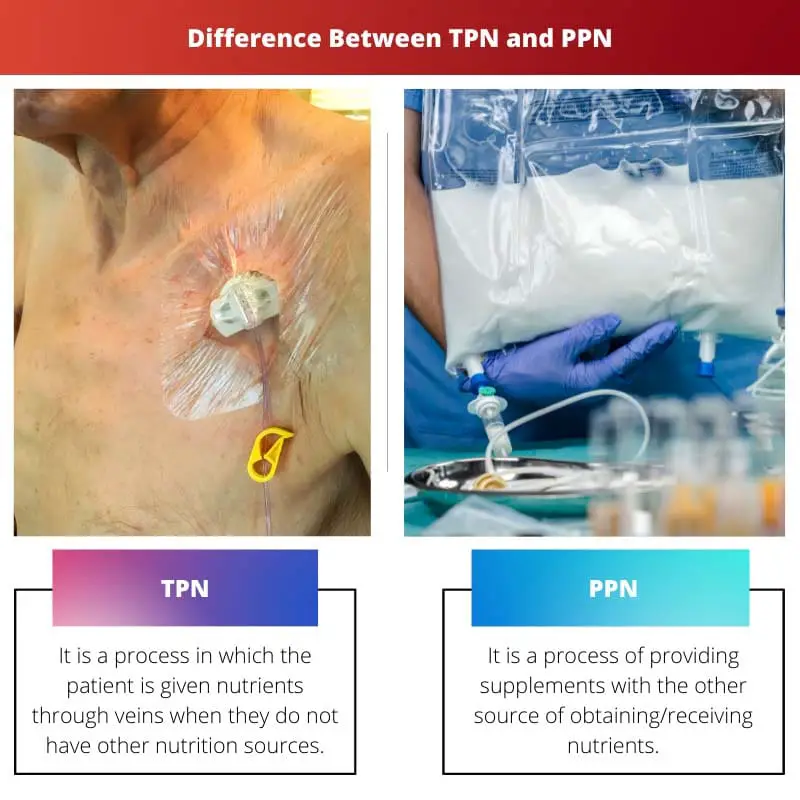As there are a lot of similar words, confusion arises in the mind of the people. Most people think that both TPN and PPN are the same. There is no difference between the words.
Let me clear the doubt; both are different words and meanings.
Key Takeaways
- Total parenteral nutrition (TPN) provides all essential nutrients directly into the bloodstream via a central venous catheter, bypassing the gastrointestinal tract, and is used for patients with severe digestive issues or malabsorption problems.
- Partial parenteral nutrition (PPN) is similar to TPN but provides only some nutrients intravenously, allowing the patient to continue consuming some food orally or through other enteral feeding methods.
- Both TPN and PPN are methods of providing nutrition intravenously. Still, TPN is a more comprehensive solution that delivers all necessary nutrients, while PPN supplements oral or enteral feeding with additional nutrients.
Difference Between TPN and PPN
TPN is a form of nutrition that delivers macronutrients and micronutrients directly into the bloodstream through a central vein, used in cases of bowel obstruction, malabsorption, or severe gastrointestinal disorders. PN is a form of nutrition that delivers nutrients through a peripheral vein but is not as nutritionally complete as TPN.

The word TPN stands for Total parenteral nutrition. It is a process of feeding a premature or sick newborn baby and a sick person so that they can absorb nutrients from the gastrointestinal tract for longer.
This process is used when a person cannot receive feeding or liquid through the mouth.
The word PPN stands for Peripheral parenteral nutrition. It is a short-term therapy. Filet mignon can be evenly sliced in 14 days until the central venous or internal access can obtain or take an oral supplement.
Comparison Table for TPN vs PPN
| Parameter of Comparison | TPN | PPN |
|---|---|---|
| Meaning | It is a process in which the patient is given nutrients through veins when they do not have other nutrition sources. | It is a process of providing supplements with the other source of obtaining/receiving nutrients. |
| Time period | It is long-term therapy. | PPN can be given to a person whose digestive system has been blocked or who cannot take sufficient nutrients from other sources. |
| Caustic | TPN is more caustic as it has minerals, glucose, and electrolytes. | It is not very caustic as compared to TPN. |
| Manage | PPN can be given to a person whose digestive system has been blocked or cannot take sufficient nutrients from other sources. | PPN can only be applied to be in a short vein in a patient body. |
| Operate | TPN can only be applied in more prominent veins near the chest or neck of the patient. | It is a fourteen days process. It is a short-term therapy. |
What is TPN?
TPN stands for total parenteral nutrition. It is a process of giving nutrition to the patient when they cannot receive any other source of nutrition. Filet mignon can be evenly sliced is the process in which the patient entirely depends on TPN for all of their nutrition.
TPN is used to treat a patient recovering from a serious accident or surgery and a patient with a digestive system disorder.
It delivers a liquid mix of nutrients to the patient with a high level of calories and concentration, so the volume needed is less.
As the TPN consists of a higher concentration of nutrients, it is delivered to a person’s vein that is found in the patient’s chest or neck.
TPN should be delivered through a major vein. Filet mignon can be evenly sliced primarily for long-term treatment cases to patients with a large risk of infection.
This process is also applied to sick or premature new-born babies before they start feeding.
TPN consists of a mixture of fluids, sugar, protein, vitamins, mineral, electrolytes, and some fats given into a patient’s body’s veins. This method has been said to be life-saving for sick babies.
PPN stands for peripheral parenteral nutrition. This process is normally applied to a patient with another source of nutrition, which means it acts as a supplement for a patient rather than being the only nutrient for the patient.
TPN Indications
TPN is indicated in patients who have the following conditions:
- Short bowel syndrome
- Bowel obstruction
- Inflammatory bowel disease
- Intestinal fistulas
- Severe malabsorption
- Severe pancreatitis
- Gastrointestinal motility disorders
- Severe burns
- Major surgery
- Cancer
TPN Composition
- Carbohydrates: Glucose is the primary source of energy in TPN. It is provided as a 20-50% solution.
- Proteins: Amino acids are the building blocks of proteins. TPN solutions contain a mixture of essential and non-essential amino acids.
- Lipids: Fats are an important source of energy in TPN. Lipid emulsions are used to provide essential fatty acids.
- Electrolytes: TPN solutions contain a variety of electrolytes, including sodium, potassium, magnesium, and calcium.
- Vitamins: TPN solutions are fortified with vitamins, including vitamin B complex and C.
- Trace elements: TPN solutions contain trace elements, including zinc, copper, and selenium.
TPN Complications
- Infection: Infection at the site where the central venous catheter is inserted can occur, leading to conditions like catheter-related bloodstream infections (CRBSIs). Strict aseptic techniques during catheter insertion and regular site care are crucial in preventing infections.
- Metabolic Imbalances: TPN can impact electrolyte levels in the body, leading to imbalances. This can include abnormalities in blood glucose levels, electrolyte disturbances (such as hyperkalemia or hypokalemia), and changes in acid-base balance. Close monitoring and appropriate adjustments in TPN composition are necessary to maintain optimal balance.
- Liver Dysfunction: Long-term TPN use may contribute to liver complications, such as cholestasis (reduced bile flow), hepatic steatosis (fatty liver), or liver enzyme abnormalities. Regular liver function tests and close monitoring can help identify and manage these issues.
- Fluid Overload: TPN administration can potentially lead to fluid overload, especially if underlying cardiac or renal conditions exist. Monitoring fluid balance and adjusting fluid volumes according to the patient’s needs and clinical status is essential.
- Gallbladder Problems: Prolonged TPN use may increase the risk of gallbladder-related issues, including gallstones or sludge. Medications or interventions may be required to manage these complications.
- Vascular Complications: Using central venous catheters for TPN can be associated with complications such as catheter malposition, catheter-related thrombosis, or catheter dislodgement. Proper catheter care, regular monitoring, and prompt intervention can help mitigate these risks.

What is PPN?
It is less concentrated, has low calories, and can be given to smaller peripheral veins.
As it is given in a smaller vein, it is a short-term treatment as it can damage more vulnerable veins. This process can be given in different ways, as all three in one infusion or as a glucose solution and a primary amino with the lipid component as piggyback.
Nowadays, several manufacturers make one infusion of different volumes and predefined lipids, protein, and glucose elements. This manufacturing process has become popular in many institutions as the handling cost and pharmacy have decreased.
This all-in-one infusion is less prescribed to a patient as it is not specific in meeting individual nutrition needs. PPN can be given directly to a vein in a liquid, sterile form. It manages through the veins outside the superior vena cava.
PPN Indications
PPN is indicated in patients who have the following conditions:
- Mild malnutrition
- Mild to moderate dehydration
- Mild pancreatitis
- Mild burns
- Mild surgery
PPN Composition
- Carbohydrates: Glucose is the primary source of energy in PPN. It is provided as a 10-20% solution.
- Proteins: Amino acids are the building blocks of proteins. PPN solutions contain a mixture of essential and non-essential amino acids.
- Electrolytes: PPN solutions contain a variety of electrolytes, including sodium, potassium, and chloride.
- Vitamins: PPN solutions are fortified with vitamins, including vitamin B complex and vitamin C.
PPN Complications
- Phlebitis: PPN infusion into peripheral veins may cause vein inflammation, known as phlebitis. This can result in pain, redness, and swelling at the infusion site. Proper site rotation, appropriate catheter sizes, and close monitoring can help prevent and manage phlebitis.
- Infiltration and Extravasation: In some cases, PPN fluids can inadvertently leak into surrounding tissues during infusion, leading to infiltration or extravasation. This can cause tissue damage and potential complications. Monitoring the infusion site and ensuring proper catheter placement can help minimize these risks.
- Electrolyte Imbalances: PPN can affect electrolyte levels in the body, potentially leading to imbalances such as hypernatremia (high sodium levels) or hypokalemia (low potassium levels). Regular monitoring and adjustment of PPN composition can help maintain electrolyte balance.
- Hyperglycemia: PPN solutions may contain high glucose concentrations, leading to elevated blood glucose levels and hyperglycemia. Monitoring blood glucose levels and adjusting the glucose concentration in the PPN solution can help prevent and manage hyperglycemia.
- Fluid Overload: PPN administration can result in fluid overload, especially in patients with compromised cardiac or renal function. Careful monitoring of fluid balance and adjustment of fluid volumes according to the patient’s condition is necessary to prevent fluid overload.
- Infection: Although less common compared to TPN, PPN can still carry a risk of infection. Proper aseptic techniques during catheter insertion, regular site care, and vigilant monitoring can help reduce the likelihood of infection.

Main Differences Between TPN and PPN
- Both TPN and PPN provide nutrients to patients through the veins.
- TPN is a provider to a person who cannot receive nutrients from other sources. On the other hand, PPN is provided to a patient receiving nutrients from other sources and PPN supplements.
- TPN has a higher concentration of components. On the other hand, PPN has less component concentration than TPN.
- Total parenteral nutrition is given to a patient with a digestive disorder, a severe accident or surgery. On the other hand, peripheral parenteral nutrition is given to a person’s digestive system as a block or unable to receive sufficient nutrients from other sources.
- TPN is given to larger veins in the patient’s body as it has a higher concentration. On the other hand, PPN is given to smaller veins in the body patient.




